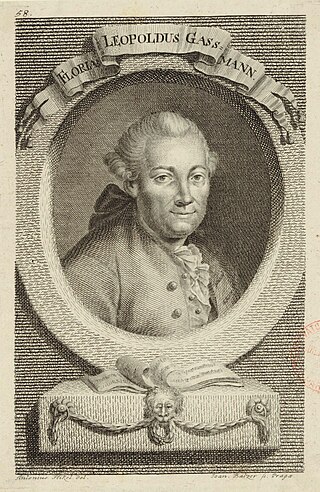Related Research Articles
C major is a major scale based on C, consisting of the pitches C, D, E, F, G, A, and B. C major is one of the most common keys used in music. Its key signature has no flats or sharps. Its relative minor is A minor and its parallel minor is C minor.
B-flat major is a major scale based on B♭, with pitches B♭, C, D, E♭, F, G, and A. Its key signature has two flats. Its relative minor is G minor and its parallel minor is B-flat minor.
E-flat major is a major scale based on E♭, consisting of the pitches E♭, F, G, A♭, B♭, C, and D. Its key signature has three flats. Its relative minor is C minor, and its parallel minor is E♭ minor,.
D minor is a minor scale based on D, consisting of the pitches D, E, F, G, A, B♭, and C. Its key signature has one flat. Its relative major is F major and its parallel major is D major.

Florian Leopold Gassmann was a German-speaking Bohemian opera composer of the transitional period between the baroque and classical eras. He was one of the principal composers of dramma giocoso immediately before Mozart. He was one of Antonio Salieri's teachers.
Wenzel Raimund Johann Birck (1718–1763) was one of the early proponents of Symphonic music in Vienna, along with Georg Christoph Wagenseil and Georg Matthias Monn, and an early tutor for Mozart. Birck also, along with Georg Christoph Wagenseil tutored a young Joseph Haydn. He was the court organist for Maria Theresia and the music teacher for emperor Joseph II.

The Symphony No. 66 in B flat major is a symphony by Joseph Haydn. The time of composition is uncertain, with one speculation from around 1775–1776. The symphony is scored for two oboes, two bassoons, two horns and strings.

The Symphony No. 62 in D major, Hoboken I/62, is a symphony written by Joseph Haydn for the orchestra at Esterháza in 1780 or 1781, a good length of time after the writing of Symphony No. 61.

The Symphony No. 61 in D major, Hoboken I/61, is a symphony by Joseph Haydn. The autograph has survived and is dated 1776.

The Symphony No. 52 in C minor is one of the last Sturm und Drang symphonies composed by the Austrian composer Joseph Haydn while the composer was in residence at Esterházy in 1771 or 1772.

The Symphony No. 56 in C major, Hoboken I/56, is a symphony by Joseph Haydn, composed by 1774. It is scored for 2 oboes, bassoon, 2 horns, 2 trumpets, timpani and strings. This is the only symphony by Joseph Haydn where he calls for the usage of both C alto horns and trumpets. It is in four movements:
- Allegro di molto, 3
4 - Adagio, 2
4 - Menuet & trio, 3
4 - Finale: Prestissimo, 4
4

The Symphony No. 51 in B♭ major, Hoboken I/51, is a symphony by Joseph Haydn, written in either 1773 or 1774, although the exact dating remains ambiguous.

The Symphony No. 30 in C major, Hoboken I/30, is a symphony by Joseph Haydn composed in 1765, at the age of 33. It is nicknamed the Alleluia Symphony because of Haydn's use of a Gregorian Alleluia chant in the opening movement.
Franz Asplmayr was an Austrian composer and violinist. There are many variants of his name, including Franz Aspelmayr, Franz Aschpellmayr and Franz Appelmeyer. He is best known for an opera on Greek myths and for a few symphonies and string trios which were once attributed to Joseph Haydn. Among the few scholars who have studied his music, there are differing opinions as to the quality. J. Murray Barbour says of Asplmayr's 80 minuets "scored mostly for oboes, horns, and strings, without violas" that "all are extremely boring, as if written between beers". Temperly, on the other hand, finds advances "with respect to harmony and developmental techniques".
Joseph Haydn's Symphony 'A' in B♭ major, Hoboken I/107, was written between 1757 and 1760. It therefore must have been composed for Count Morzin's orchestra, for whom Haydn worked until 1761.
The six string quartets, K. 168–173, were composed by Wolfgang Amadeus Mozart in late 1773 in Vienna. These are popularly known as the Viennese Quartets. Mozart may have hoped to have them published at the time, but they were published only posthumously by Johann André in 1801 as Mozart's Op. 94.
References
- ↑ Antony Hodgson, The Music of Joseph Haydn: The Symphonies. London: The Tantivy Press (1976): 74".
- ↑ Heartz, Daniel (1995). Haydn, Mozart, and the Viennese School, 1740-1780: 1740-1780 at Google Books, p. 87, W. W. Norton & Company (1995) ISBN 0-393-96533-3
- ↑ See manuscript score @ IMSLP.
- ↑ https://www.dacapo-records.dk/en/recordings/langgaard-symphonies-nos-2-and-3